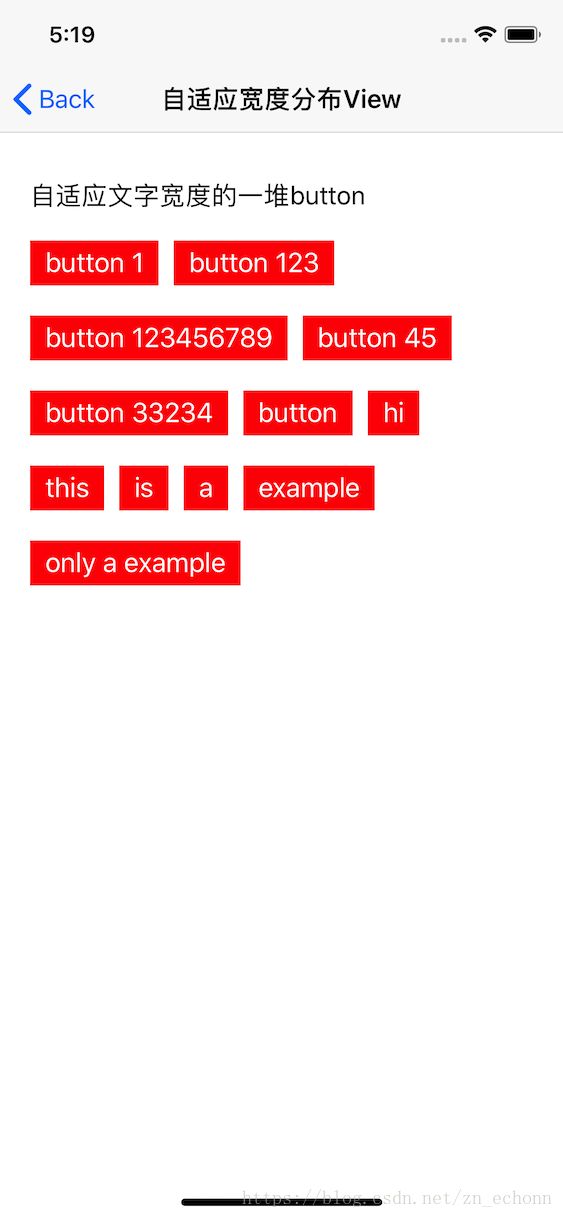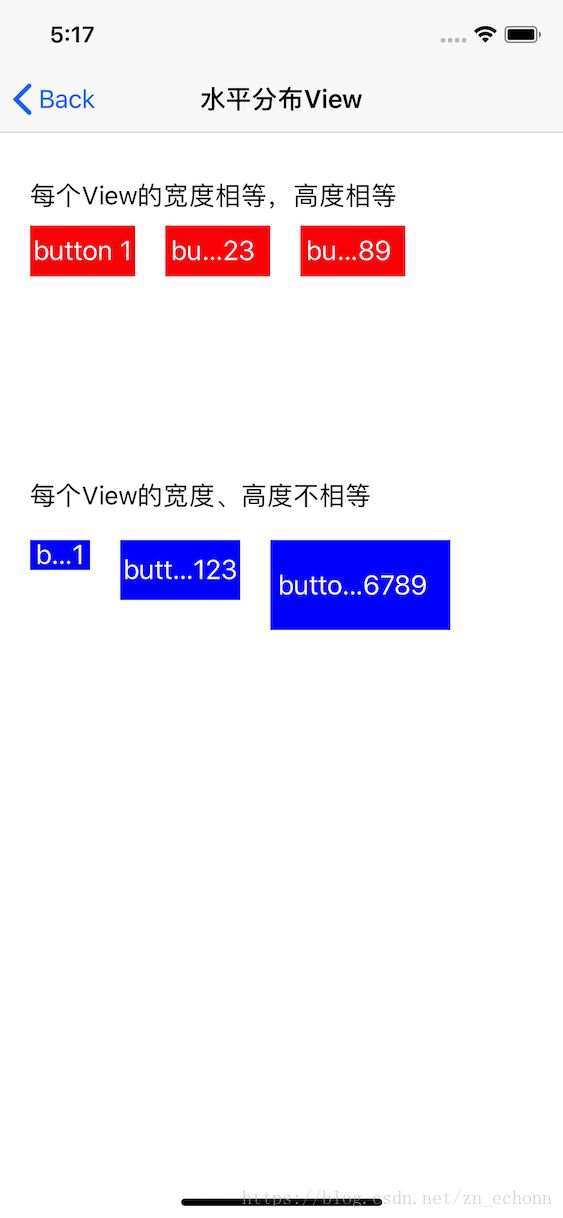SnapKit 关于数组Array的扩展—— 自适应宽度、垂直、水平、九宫格布局
SnapKit 关于数组Array的扩展—— 自适应宽度、垂直、水平、九宫格布局
前言
用SnapKit这个第三方写自动布局,使用起来的确很舒服,但是对于Array却没有相关的支持,然后在网上找了这篇文 SnapKit的扩展–添加数组控制约束,和九宫格布局,等宽,等间距等布局方式 ,感谢
但是只有水平、垂直、九宫格布局,如果我想让多个button,按它的title的内容的宽度自适应排列呢,所以,决定自己写个扩展,参考了上面那篇文的代码,并做了一些修改。
其具体实现及Demo代码如下: Github 地址
仅供参考,希望有所帮助,如果你有什么好的方式,请告知,感谢。
以下为展示的效果例子及说明:
自适应宽度布局
public func distributeDetermineWidthViews(verticalSpacing: CGFloat,
horizontalSpacing: CGFloat,
maxWidth: CGFloat,
determineWidths: [CGFloat],
itemHeight: CGFloat,
edgeInset: UIEdgeInsets = UIEdgeInsets.zero,
topConstrainView: ConstraintView? = nil) // verticalSpacing 每个view之间的垂直距离
// horizontalSpacing 每个view之间的水平距离
// maxWidth 是整个布局的最大宽度,需要事前传入,比如 self.view.bounds.size.width - 40
// textWidth 是每个view的宽度,也需事前计算好
// itemHeight 每个view的高度
// edgeInset 整个布局的 上下左右边距,默认为 .zero
// topConstrainView 整个布局之上的view, 从topConstrainView.snp.bottom开始计算,
// 比如,传入上面的label,则从 label.snp.bottom + edgeInset.top 开始排列, 默认为nil, 此时布局从 superview.snp.top + edgeInset.top 开始计算
btnArr.snp.distributeDetermineWidthViews(verticalSpacing: 20, horizontalSpacing: 10, maxWidth: self.view.bounds.size.width - 40, determineWidths: textWidth, itemHeight: 30, edgeInset: UIEdgeInsetsMake(20, 20, 0, 20), topConstrainView: label)虽然说是自适应宽度,但是一开始需要自己计算每个view的宽度再传入,而且还得传最大宽度QUQ,但是除了这样,我也不知道怎么做比较好了,如果你知道,求告知。
九宫格布局
public func distributeSudokuViews(verticalSpacing: CGFloat,
horizontalSpacing: CGFloat,
warpCount: Int,
edgeInset: UIEdgeInsets = UIEdgeInsets.zero,
itemHeight: CGFloat? = nil,
topConstrainView: ConstraintView? = nil)第一个九宫格分布:
黄色为所有view的容器,每个view之间的边距(垂直/水平)固定,高度未知,那么其实际高度与view的容器高度有关
// verticalSpacing 每个view之间的垂直距离
// horizontalSpacing 每个view之间的水平距离
// warpCount 每行多少列
// edgeInset 整个布局的 上下左右边距,默认为 .zero
// itemHeight 每个view的高度, 默认为 nil,可以不指定,那么每个view的高度就按整个容器的高度来确定
// topConstrainView 整个布局之上的view, 从topConstrainView.snp.bottom开始计算,
// 比如,传入上面的label,则从 label.snp.bottom + edgeInset.top 开始排列, 默认为nil, 此时布局从 superview.snp.top + edgeInset.top 开始计算
views.snp.distributeSudokuViews(verticalSpacing: 10, horizontalSpacing: 30, warpCount: 3, edgeInset: UIEdgeInsetsMake(10, 10, 10, 10), itemHeight: nil, topConstrainView: label)第二个九宫格分布:
橙色为所有view的容器,这个例子,高度确定,那么与容器的高度无关
// itemHeight 每个view的高度指定
views.snp.distributeSudokuViews(verticalSpacing: 10, horizontalSpacing: 30, warpCount: 3, edgeInset: UIEdgeInsetsMake(10, 10, 10, 10), itemHeight: 20, topConstrainView: label)垂直布局
第一个垂直分布的例子,指定了按钮的高度(fixedItemLength),即每个按钮的高度都相等
// axisType 垂直或水平
// fixedItemSpacing 每个view之间的距离
// edgeInset 整个布局的 上下左右边距,默认为 .zero
// fixedItemLength 垂直时,是每个view的固定高度, 默认为 nil, 可不传,不传的例子见下面
// topConstrainView 整个布局之上的view, 从topConstrainView.snp.bottom开始计算,
// 比如,传入上面的label,则从 label.snp.bottom + edgeInset.top 开始排列, 默认为nil, 此时布局从 superview.snp.top + edgeInset.top 开始计算
btnArr.snp.distributeViewsAlong(axisType: .vertical, fixedItemSpacing: 20, edgeInset: UIEdgeInsetsMake(10, 40, 0, 40), fixedItemLength: 30, topConstrainView: label)当然,如果你想让它每个button的宽度不一样也可以(默认水平居中,即CenterX与superview一样),可以遍历一遍对每个button做如下操作
btn.snp.makeConstraints({ (make) in
make.width.equalTo((i + 1) * 40)
})或者
btnArr.snp.makeConstraints { (make) in
make.width.equalTo(60)
}第二垂直分布的例子,不设置固定高度 fixedItemLength,那么随便你设置高度和宽度呗
// fixedItemLength 为nil 时, 可为每个view设置宽高,
// 当然,也可以不设置宽度,但是对高度一些可以不设置,比如label、button
btnArr.snp.distributeViewsAlong(axisType: .vertical, fixedItemSpacing: 30, edgeInset: UIEdgeInsetsMake(360, 20, 0, 20))同理,遍历一遍对每个button做如下操作
btn.snp.makeConstraints({ (make) in
make.height.equalTo((i + 1) * 20)
make.width.equalTo((i + 1) * 40)
})或
btnArr.snp.makeConstraints { (make) in
make.height.equalTo(30)
make.width.equalTo(60)
}水平布局
跟垂直分布一样,只是垂直参数,换成了水平
第一个例子,设置fixedItemLength,固定宽度,但是高度还是可以设置
// fixedItemLength 水平时,是每个view的固定宽度, 默认为 nil, 可不传,不传的例子见下面
btnArr.snp.distributeViewsAlong(axisType: .horizontal, fixedItemSpacing: 20, edgeInset: UIEdgeInsetsMake(10, 20, 0, 20), fixedItemLength: 70, topConstrainView: label)同理,遍历一遍对每个button做如下操作
btn.snp.makeConstraints({ (make) in
make.height.equalTo((i + 1) * 20)
})或者
btnArr.snp.makeConstraints { (make) in
make.height.equalTo(60)
}第二个例子,不设置固定宽度 fixedItemLength,那么随便你设置高度和宽度呗
// fixedItemLength 为nil 时, 可为每个view设置宽高,
// 当然,也可以不设置宽度,但是对高度一些可以不设置,比如label、button
btnArr.snp.distributeViewsAlong(axisType: .horizontal, fixedItemSpacing: 20, edgeInset: UIEdgeInsetsMake(360, 20, 0, 20))


